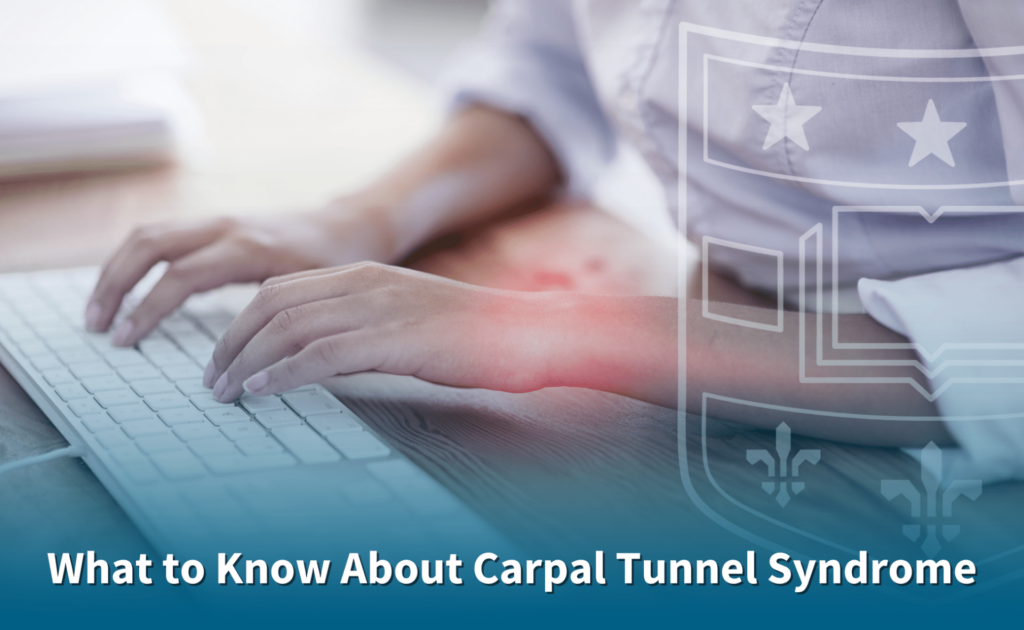That uncomfortable pins-and-needles feeling we experience from time to time is often caused by blood flow being temporarily cut off to the nerves. This can happen when we put awkward pressure on part of our body for a period of time, such as when you fall asleep on your arm or sit too long in an uncomfortable position. Once you shift your position and allow blood flow to return to normal, the feeling usually goes away. But in the case of more severe nerve compression or damage, the numbness, weakness and tingling can persist long term. If not treated, this can sometimes lead to chronic progressive conditions and lasting nerve damage. One of the most common of these conditions is carpal tunnel syndrome.
What causes carpal tunnel syndrome?
Carpal tunnel syndrome is caused by the compression or irritation of the median nerve, which runs through a tight tunnel in the wrist called the carpal tunnel. This nerve is responsible for providing sensation to the thumb and the first three fingers. When compressed or damaged, the median nerve cannot function properly, leading to the telltale tingling and numbness attributed to carpal tunnel syndrome. This sensation (or lack thereof) most often occurs in the hand and fingers, but can sometimes move up the wrist and arm. While a temporary pins-and-needles feeling in part of the body is normal from time to time, carpal tunnel syndrome is marked by a much more persistent numbness that interferes with your daily life.
Small, repetitive motions of the hand, such as frequent typing on a keyboard, use of hand and power tools and certain repetitive movements in some sports, are recognized as the most common factors associated with median nerve compression and carpal tunnel syndrome.
You may be at a greater risk for worsening this condition if your job or hobbies involve improper or overuse of your hands and wrists. Forceful, repetitive gripping or twisting of the wrist, for example, can put pressure on or cause damage to the median nerve. Any task which requires repetitive hand and wrist motions can aggravate it – knitting, painting, scrolling on your phone, chopping vegetables – the list goes on. Other factors that are associated with carpal tunnel syndrome include arthritis, fluid retention (sometimes occurring during pregnancy and menopause), diabetes and injury of the wrist. There is typically not one singular cause for this condition; it is often thought of to be caused by a combination of several different factors or conditions over time.
What are the symptoms of carpal tunnel syndrome?
The most common symptoms of carpal tunnel syndrome are persistent pain, numbness, tingling or pins-and-needles in the hand and fingers. These sensations, as with many similar nerve conditions, can feel different from person to person.
Some people report a burning or buzzing sensation, swelling in the fingers or the occasional feeling of a minor electric shock in the affected area. Another common indication of carpal tunnel syndrome is weakness in the hands. You may have trouble maintaining a strong grip or find yourself dropping objects unintentionally. When these symptoms persist for several weeks consistently or begin to interfere with your day-to-day activities, work or sleep, it may be time to see a doctor. If left untreated, carpal tunnel syndrome can worsen over time, so it is important to catch the condition early.
How is carpal tunnel syndrome treated?
While there are several ways to manage carpal tunnel syndrome, surgery is often considered the most effective long term treatment. Nonsurgical options include splinting the wrist to keep it immobile and relieve compression of the median nerve, taking anti-inflammatory medication to reduce swelling around the nerve or making a change in your job or hobbies if they require the repetitive motions that can worsen the condition.
Surgery may seem like a drastic option, but carpal tunnel release surgery is often considered to be a relatively minor surgery. While some patients require general anesthesia, most patients can receive local anesthetic, remain awake for the duration of the surgery and go home the same day. During this procedure, the surgeon makes an incision into the wrist and releases the tissue that is putting pressure on the median nerve. This immediately relieves the compression on the nerve and allows it the space to heal and function properly.
Every case of carpal tunnel syndrome is different, and, depending on how long you have been experiencing symptoms and their severity, recovery may be shorter or longer for some patients. Recovery times also vary based on how often you use the hand that requires surgery: If you have surgery on your dominant hand or do lots of intense lifting or repetitive motions at work, you may require more rest to fully recover before getting back to work and activities. If surgery is an option for you, your doctor will discuss your individual case and give you an idea of what to expect during your surgery and recovery.
Washington University Hand Surgery
Washington University Plastic and Reconstructive surgeons have extensive experience in all kinds of hand surgery. Our world-class hand surgeons ensure that each patient understands their options when it comes to their individual treatment plan and prioritize only the highest quality care. Chronic nerve conditions such as carpal tunnel syndrome can greatly impede on work, hobbies, sleep and daily life. Carpal tunnel specialists at Washington University focus on helping patients find relief from their symptoms and get back to living their lives pain-free. Our physicians offer virtual and in-person visits to help get you the care you need.
